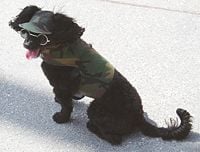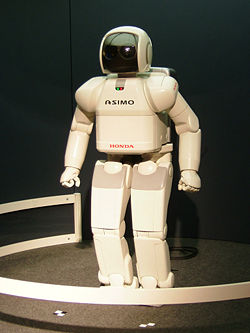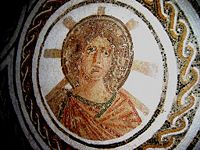Anthropomorphism
Anthropomorphism is the attribution of human characteristics and qualities to non-human beings, objects, natural, or supernatural phenomena. A form of personification (applying human or animal qualities to inanimate objects), anthropomorphism is similar to prosopopoeia (adopting the persona of another person). Animals, the forces of nature, and unseen or unknown authors of chance are frequent subjects of anthropomorphosis.
The term comes from two Greek words, άνθρωπος (anthrōpos), meaning "human", and μορφή (morphē), meaning "shape" or "form". The suffix '-ism' originates from the morpheme '-isma' in the Greek language.
In religions and mythologies
In religion and mythology, "anthropomorphism" refers to the perception of a divine being or beings in human form, or the recognition of human qualities generally, in these beings. Many mythologies are almost entirely concerned with anthropomorphic deities who express human characteristics such as jealousy, hatred, or love. The Greek gods such as Zeus and Apollo were often depicted in human form exhibiting both commendable and despicable human traits.
Biblical literalism
Numerous different sects throughout history have been called anthropomorphites, including a sect in Egypt in the 4th century, and a group in the Roman Catholic Church in the 10th century. Such sects were considered heretical for their biblical literalism, taking everything written and spoken of God in the Bible in a literal sense. This included attributing to God a human form, human parts, and human passions. The passage they chiefly referred to was Genesis 1:27, listed below in the original Hebrew, and in the New American Standard Bible translation into English. [2]
| “ | וַיִּבְרָא אֱלֹהִים אֶת-הָאָדָם בְּצַלְמוֹ, בְּצֶלֶם אֱלֹהִים בָּרָא אֹתוֹ: זָכָר וּנְקֵבָה, בָּרָא אֹתָם.
God created man around His own image, in the image of God He created him; male or female He created them. |
” |
Hinduism
The ten avatars of the Hindu supreme God Vishnu possess both human and divine forms and qualities, although their divinity varies in degree. In Vaishnavism, a monotheistic faith, Vishnu is omniscient and benevolent, unlike gods of the Greek and Roman religions. See Conceptions of God in Hinduism.
Condemnation
Numerous religions and philosophies have condemned anthropomorphism for various reasons. Some Ancient Greek philosophers did not condone, and were explicitly hostile to, their people's mythology. These philosophers often developed monotheistic views. Plato's (427–347 B.C.E.) Demiurge (craftsman) in the Timaeus and Aristotle's (384–322 B.C.E.) prime mover in his Physics are examples. The Greek philosopher Xenophanes (570–480 B.C.E.) said that "the greatest God" resembles man "neither in form nor in mind." (Clement of Alexandria, Miscellanies V xiv 109.1-3). The similarity of these philosophers' concepts of God to that of the Bible's facilitated the incorporation of much pre-Christian Greek philosophy into the Medieval Christian world view by the Scholastics, notably Thomas Aquinas.
From the perspective of believers of a religion where the deity or deities have human characteristics, it may be more accurate to describe the phenomenon as theomorphism, or the giving of divine qualities to humans, instead of anthropomorphism, the giving of human qualities to the divine. The reason for this being that according to their beliefs, the deity or deities usually existed before humans, and therefore humans were created in the form of the divine, not vice versa. However, for those who do not subscribe to the beliefs of the religion, the phenomenon can be considered anthropomorphism.
In rhetoric
Anthropomorphism in the form of personification consists of creating imaginary persons who are the embodiment of an abstraction such as Death, Lust or War. See the article on the Four Horsemen of the Apocalypse for notable examples.
In classical rhetoric, personification is a figure of speech (more specifically a trope) that employs the deliberate use of anthropomorphism, often to make an emotional appeal. In rhetorical theory, a distinction is often drawn between personification (anthropomorphism of inanimate, but real, objects) and figures such as apostrophe, in which an absent people or abstract concepts are addressed.
An example of rhetorical personification:
- A tree whose hungry mouth is prest
- Against the earth's sweet-flowing breast. Joyce Kilmer, Trees
An example of rhetorical apostrophe:
- O eloquent, just, and mighty Death! Walter Raleigh, History of the World

In literature
Anthropomorphism is a well established device in literature, notably in books for children, such as those by C.S. Lewis, Beatrix Potter, Roald Dahl and Lewis Carroll. Also, Rev. W. Awdry's Railway Series depicts steam locomotives with human-like faces and personalities.
Terry Pratchett is notable for having several anthropomorphic personifications in his Discworld books. Perhaps best known is the character Death. Piers Anthony also wrote a series regarding the seven incarnations of Death, Time, Fate, War, Nature, Evil, and Good. Neil Gaiman is notable for anthropomorphising seven aspects of the world in his series Sandman - they are called the Endless: Destiny, Death, Dream, Destruction, Desire, Despair, and Delirium.
The Indian books Panchatantra (The Five priniciples) and The Jataka tales employ this trick of anthropomorphized animals very effectively to illustrate various principles of life.
It may be noted that the majority of monsters and fantastical beings portrayed in Science Fiction and Fantasy, are extremely anthropomorphic, having only superficial details (such as ears or colour of skin) that differ from normal humans.
Common usage
It is a common tendency for people to think of inanimate objects as having human-like characteristics. Few, if any people, believe this to have real significance. Common examples of this tendency include naming one's car or begging a machine to work. In 1953 the U. S. Government began assigning hurricanes female names. A few years later they added male names. Historically, storms often were named after saints.
Advances in artificial intelligence are beginning to identify such foibles as a potentially more significant phenomenon as computers begin to reach the point where they can recognize spoken language. Some computers are already very good at displaying very specific and specialized categories of human-like behaviour, such as learning from their mistakes or anticipating certain input, playing chess and other games with which require human-like intelligence; even—in the case of robots—potentially taking on humanlike form. Anthropomorphobia, a phobia traditionally associated with anxiety responses to nonhuman living things displaying human behavior, is now used to define the phobia of nonliving things that exhibit human qualities.
Technical use
Hackers and programmers have always anthropomorphised technology, mostly as a time-saving metaphorical device. Complex technology, specifically computers, can exhibit complicated behavior that can be lengthy to describe in purely inanimate terms. Hackers, therefore, may use human actions and even emotions to describe a computer system's behavior. For example, in a situation where a program encounters minor errors but can still accomplish its task, it may do so but emit an error message. Especially in cases where the error encountered is thought to be trivial, a hacker might say that the computer is complaining. This human action (complaining) conveys that there is a difficulty while acknowledging the triviality of the difficulty, and perhaps the fact that the program does what was required despite the difficulty. See the section on anthropomorphism in the Jargon File for more information, including the self-referentially hackish joke on the topic "Don't anthropomorphize computers: they hate that."
This form of anthropomorphism is common in other technical fields as well. For example, a chemist might casually explain an ionic bond between sodium and chlorine by asserting that the sodium atom "wants" to merge with the chlorine atom, even though atoms are incapable of having a preference. On the other hand, in finance, when a financial market rises and falls, it might be described as "fickle", but because it is a human-driven process based on human reactions to market forces, it is capable of reflecting, if not having, human emotions. If the criterion for anthropomorphism is that the subject is ascribed human attributes it does not have, then financial markets and other demographic forces may not qualify. However, they might be considered true personifications of human emotion, and qualify the same way as the personification of desire does.
However, such uses might better be described as animism, since the features falsly attributed to inanimate objects are those of sentient beings (animals) rather than just those of humans.
Modern occurrences
The use of anthropomorphized animals has a long tradition in art and literature. Frequently they are used to portray stereotypical characters, in order to quickly convey the characteristics the author or artist intends for them to possess. Examples include Aesop's fables, George Orwell's Animal Farm and political cartoons, e.g. Maus. Many of the most famous children's television characters are anthropomorphized funny animals: Mickey Mouse, Kermit the Frog, Bugs Bunny, Daffy Duck, and Scrooge McDuck, for example. While being "funny" is a common trait, it is not a hard rule; Bert the Turtle, star of Duck and Cover is a children-oriented exception. While children-and-family-oriented series have often featured anthropomorphic animals, newer adult-oriented television series such as Family Guy also make use of anthropomorphized characters. The Playstation 2 game Sly Cooper and the Thievius Raccoonus also features anthropomorphized characters. Sonic The Hedgehog also features anthropomorphized animals, but with colored fur or skin unlike that of normal animals.
The human characteristics commonly ascribed to animals in popular culture usually centers on either their perceived personality or disposition (for example, owls are usually designated as wise); their appearance alone (penguins are usually portrayed as plump aristocrats, because their plumage resembles a tuxedo); or a combination of both (raccoons are commonly portrayed as bandits, both because of the characteristic black stripe over their eyes, which resembles the stereotypical mask of a bandit, and because they roam at night, sometimes breaking into peoples' garbage). It should be noted, however, that such personification can be modern or ancient. For example, foxes are portrayed as cunning and have been for thousands of years, but penguins were not widely known of before the 20th century and so all anthropomorphic behaviour associated with them is modern.
One example of modern anthropomorphism is 'OS-tan', an Internet phenomenon on Futaba Channel that personifies computer programs, mostly operating systems like Windows, Linux and Mac OS 9.
Since the 1980s, furry fandom has focused on the appreciation, promotion, and production of stories and art about anthropomorphic animals, as well as the exploration, interpretation and examination of humanity and human values through anthropomorphic expression. Furry fandom and the Furry subculture it is part of have only recently come to the attention of the media.
Anthropomorphism has also been frequently applied to entities other than animals in modern times. The red blood cells in the film Osmosis Jones and robots in Stanisław Lem's The Cyberiad may be considered examples of anthropomorphism. The Discworld novels by Terry Pratchett contain characters such as Death and Time, who refer to themselves as anthropomorphic personifications of fundamental forces. Similarly, the automobiles that are the focus of the 2006 Disney/Pixar movie Cars can also be seen as anthropomorphic. In all of the Star Fox video games both the protagonists and antagonists are anthropomorphic animals with the exception of R.O.B. the robot.
In logical reasoning

Using anthropomorphized caricatures or projecting human qualities on conceptual entities or inanimate objects in reasoning is also known as committing a pathetic fallacy (not a pejorative term).
See also
- Anthropomorphobia
- Anthropopathy
- Figure of speech
- Humanoid
- Kemono
- List of anthropomorphic personifications
- Louis Wain
- Moé anthropomorphism
- National personification
- OS-tan
- Pathetic fallacy
- Rhetoric
- Uncanny Valley
ReferencesISBN links support NWE through referral fees
- This article incorporates content from the 1728 Cyclopaedia, a publication in the public domain. Anthropomorphite.
- Shipley, Orby. ed. A glossary of ecclesiastical terms. 1872.
External links
- Kind I Like - A photographic collection of objects that look like people.
- Anthropomorphism at The Encyclopedia of Astrobiology, Astronomy, & Spaceflight
- Anthropomorphic - Design Dictionary Aspect that relates with human body shapes.
bg:Антропоморфия da:Antropomorfisme de:Anthropomorphismus el:Ανθρωπομορφισμός es:Antropomorfismo eo:Antropomorfismo fr:Anthropomorphisme ia:Anthropomorphismo hu:Megszemélyesítés nl:Antropomorfisme ja:擬人観 no:Prosopopeia pl:Antropomorfizm pt:Antropomorfismo ro:Antropomorfism ru:Антропоморфизм simple:Anthropomorphism fi:Antropomorfism sv:Antropomorfism tr:İnsan biçimcilik zh:擬人化
Credits
New World Encyclopedia writers and editors rewrote and completed the Wikipedia article in accordance with New World Encyclopedia standards. This article abides by terms of the Creative Commons CC-by-sa 3.0 License (CC-by-sa), which may be used and disseminated with proper attribution. Credit is due under the terms of this license that can reference both the New World Encyclopedia contributors and the selfless volunteer contributors of the Wikimedia Foundation. To cite this article click here for a list of acceptable citing formats.The history of earlier contributions by wikipedians is accessible to researchers here:
The history of this article since it was imported to New World Encyclopedia:
Note: Some restrictions may apply to use of individual images which are separately licensed.

